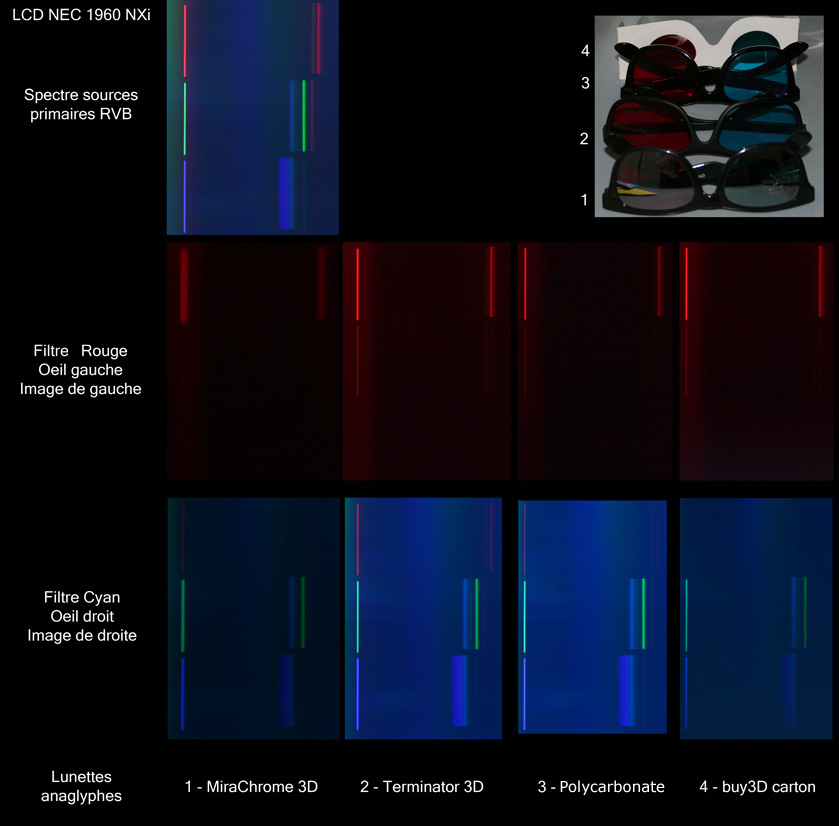To recreate volume, the brain needs two captured images since two spaced points of a distance called the stereo basis. Our two eyes are spaced approximately 6,5 to 7 cm. This basis between the two images obtained by each eye introduces a parallax of vision - shift angular which is enough with the brain to appreciate differences in distances and volume until approximately 2 km.
Sensory physiology, eye-brain-colors:
The color does not exist independently of the observer; it is a concept mixing with the physical aspects, physiological and psychological. In fact, it is because there is the brain and its interpretation of the various luminous flows received by the eyes which we appreciate/distinguish from the nuances between the received lights and thus from the colors. For example, the magenta does not exist “monochromaticly”. There is no physically magenta monochromatic wavelength perceived by the brain. We perceive the magenta color when the luminous flow received by our eyes contains red and blue.
Retina - retina is papered photosensitive receivers used in diurnal them cones but not in vision nocture/scotopic vision of day/where only them rods remain active. Three types of cones make it possible to appreciate the colors: cones L for the red tape, cones M for the green tape, cones S for the blue tape. The sticks R (od) cover especially the cyan but are used as sensors “black & white”. The feeling of yellow, which can be produced by a quasi-monochromatic light exciting separately equalizes the adhesives L and M (and almost not S) or also by the superposition of a red light which excites especially the cones L and of a green light which excites especially the cones Mr.
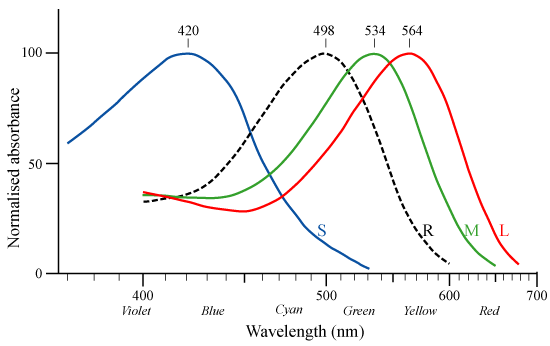
Wikipedia: Spectral absorption curves off the shorts (S), medium (M) and long (L) wavelength pigments in human cone and rod (R) concealments.

Wikipedia: Axial organization off the retina.
Cerebral interpretation - psychological is also very important, for example the perceptions misled with a shade on a checkerwork of indentic levels of gray of Edward Adelson' S checker, for the illusions of perception of luminosity.
Refund of a coloured image, the screen:
Better than of long writings, colorimetric diagram CIE 1931 - below illustrates perfectly the theoretical space of the colors which it is possible to perceive by omitting the basic negotiable instruments luminance (which reveal hues folded back like chestnut). It is also very practical to understand the combination/synthesis/mixture of the colors. The whole of the spectral colors (i.e colors of the monochromatic lights - or various wavelengths of visible) is represented on the diagram by this curve in the form of horseshoe graduated from 380 to 700 Nm, the “spectrum locus” or place of the visible spectrum. You notice very easily that the spectrum locus, and thus this whole of the colors comparable with that of a rainbow), schematically seem to us especially made up of red, green and blue.
It is thus logical that to create the maximum of possible colors, one uses at least the two extreme colors of the spectrum, red and blue and the “central position”, the green which are also the tapes of sensitivity of the cones of the retina. The basic colors for the synthesis/additive creation of other colors are thus the colors Red, Green and Blue. The addition or mixes several different coloured flows - colors of basis will be interpreted by the brain like another color present on this diagram. Thus in additive synthesis (one lights the purpose by adding light), if one mixes in quantity adapted of the colors to dominant very red, green and blue, one will obtain a white. Typically three primary sources of light are used but one can use some more. These primary sources are not inevitably monochromatic - on the spectrum locus, i.e. which they can contain several other photons different wavelengths:
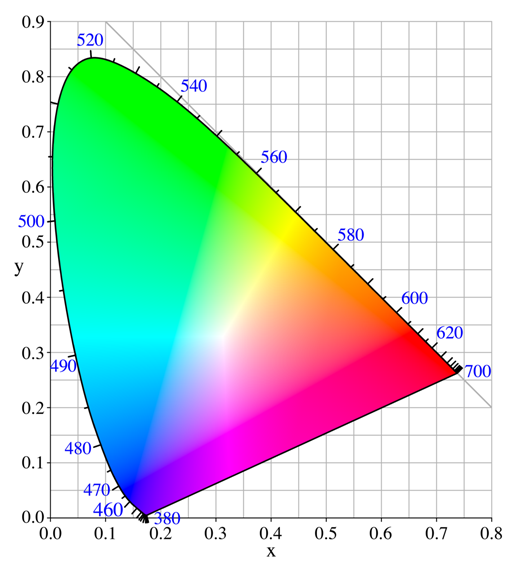
Wikipedia: Diagram Co
In the case which interests us, a monitor/screen is a device which recreates the colors by additive synthesis of three basic colors RGB not monochromatic - English RGB whose spectra are relatively broad. For example, the green source issues slightly in the red - thus on the place of the image of left whereas the green leads the image of straight line what produces an inconsistency for the brain. The diagram below represents these three typical basic colors of the primary sources of screens LCD/OLED, located on diagram XY of the Co. You notice the triangle represented between these primary sources of light. It is very important because its surface contains the whole of the colors which it is possible to create by their dosage, the space of the colors or gamut. All the colors apart from this triangle ARE NOT synthesizable with these three primary colors. It is understood already that with only three primary sources, it is impossible to synthesize the whole of the colors which the brain can perceive. A monitor screen cannot thus represent all the TRUE nature colors… But it synthesizes an image which approaches some much by the equations with amounts egality: White=Red+Green+Blue, Yellow=Red+Green, Cyan=Green+Blue, Magenta=Red+Blue, Black=no luminous flow. All the other colors are shade :
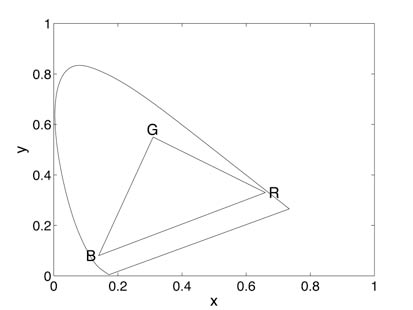
Primary sources RVB typical of the digital screens, all the colors are not synthesis.
These sources are not monochromatic.
In the case of a printer which poses ink on a white leaf, ink absorbs some spectral components of the incidental white light which clarifies the image. It is about a subtractive synthesis since it is due to a subtraction of the colors to the white: Magenta=White-Green, Cyan=White-Red, Yellow=White-Blue + Black to obtain major blacks.
Spectra of primary sources RGB of a screen: It is enough to be placed in a relative darkness, to display slits coloured out of full-screen, to move away from 1,5m and to observe it while placing in front of its eye a diffraction grating (Jeulin of school 140 features/mm) to admire the emissive spectra. These images speak about them same but note the difference between the spectra obtained and especially that the red sources issue in the green and sometimes blue, the green sources are really very broad and the blue sources often issue in the green. It is obviously the most problematic source green for an anaglyph because it introduces part of the right image as left image what can disturb the brain.
Primary sources spectra of screens CRT, LCD, LED…
PowerPoint slits, slit 1, slit 2, slit 3, slit sizes 4.
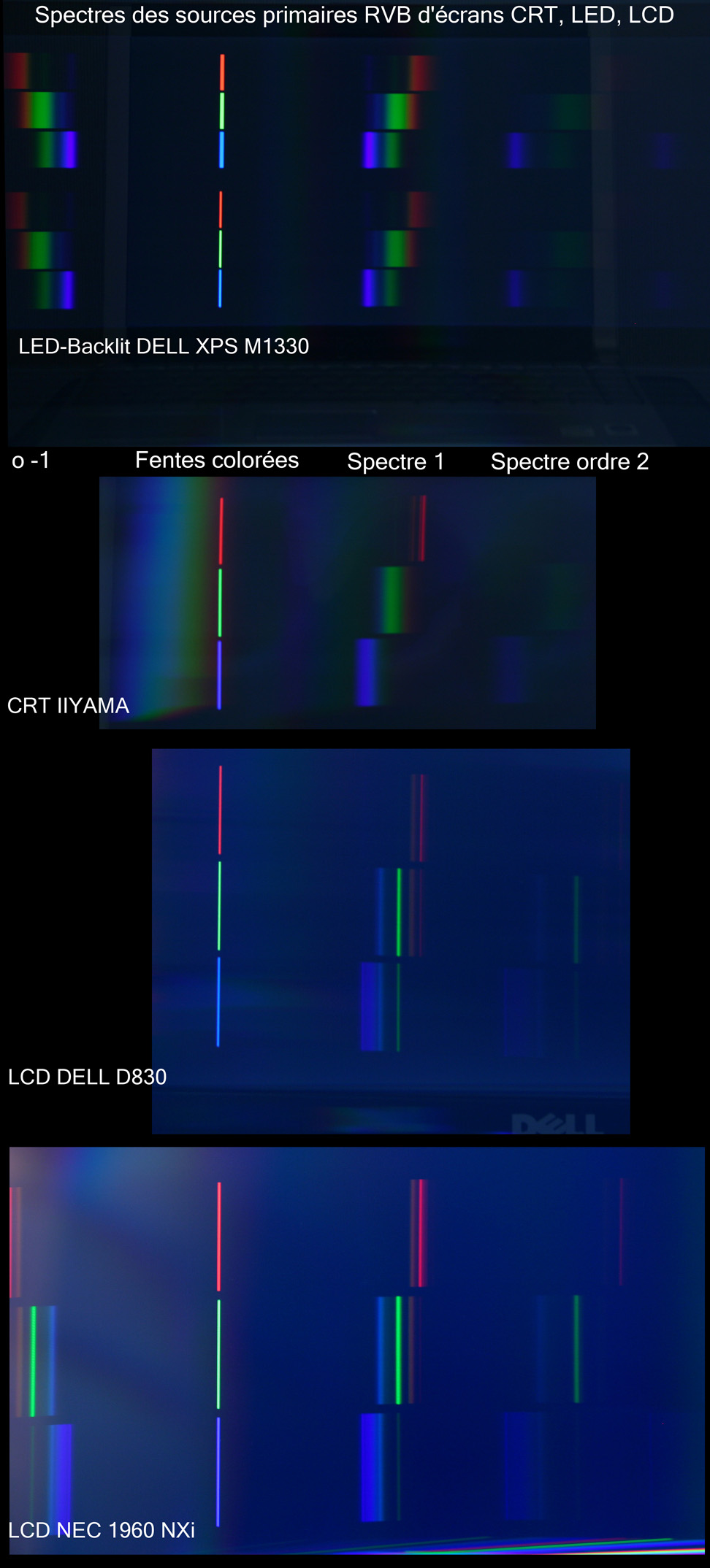
Primary sources spectra of screens CRT, LCD, LED…
Here the space of color more used for the monitors, printers and the Internet, the sRGB which contains a white says D65 produced by three components RVB adapted to a use under conditions common to work or the house :
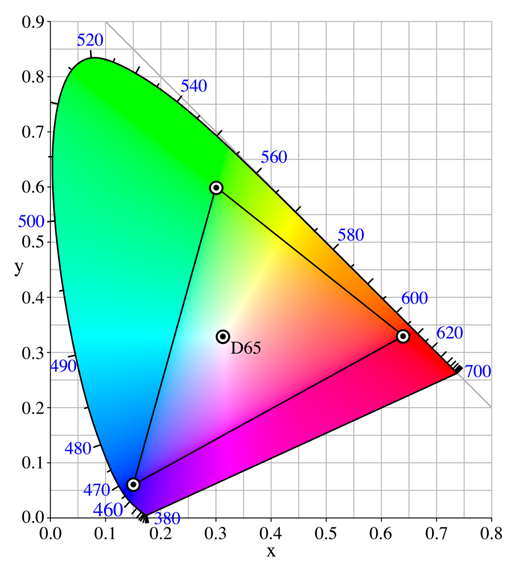
Wikipedia: sRGB sources
The reproduction of a white can be rather reddish, greenish or bluish because of the real device which produces the “white” light, fluorescent tube of the LCD display, filament of a bulb… This concept is associated with the temperature of a black body, the color temperature, here the locus of the issuing of a black body according to its temperature on diagram CIE. By amending the color temperature of a screen in his menu, one thus amends inevitably the white which it restores and thus colors that it will synthesize:
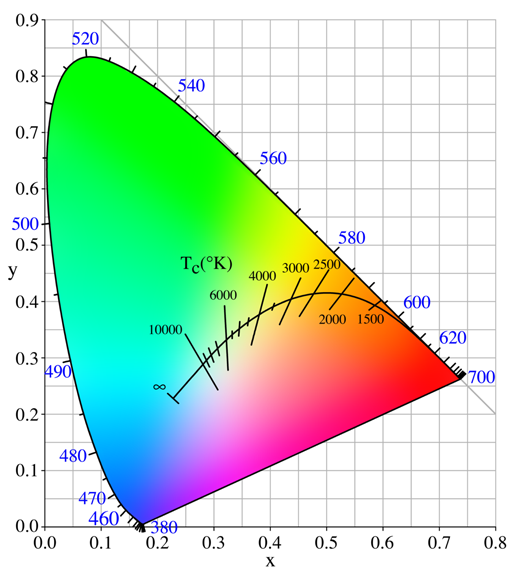
Wikipedia: color temperature.
“Coding/Decoding” of the relief in only one image, the anaglyph:
A usual anaglyph (red/cyan) “code” the relief because it contains the image of the left eye in its red component and the image of the right eye in its component cyan (green+blue). The glasses are thus fitted with a red filter on the left eye and with a filter cyan on the right eye, to inject the theoretical good image in the good eye. The brain makes a synthesis of the two images and recreates the relief/volume and the approximate colors. Its capacities, its speed and its power are frightening…
To test and regulate, optimize the screen-glasses pair :
The glasses sold for the visualization of the anaglyphs do not have pure and complementary filters. For you to convince some, it is enough to look at the following sighting by alternatively masking each eye - and thus filter to consider band-width of your various glasses. Components RGB of the monitor are represented minimal flow until possible maximum flow. By masking the right eye, one perceives very clearly that the Rouge filter of the glasses lets pass a little green and very little blue. With a pure red filter, one should observe the red tape and the green and blue tapes completely black since the red filter should let pass ONLY the red. Idem with the cyan filter of the glasses, by masking the left eye, one perceives red light in his tape beyond 80% of maximum flow… What wants to say that actually and very often, the glasses inject you the left image + a little right image in the left eye and right image + a little the left in the right eye. According to its importance, this problem causes a noncomfortable/vibrating vision of the anaglyph because the brain receives each eye of information not corresponding to a normal binocular vision, and which thus seem to him incoherent. The monitor - glasses pair is thus extremely important for the visualization of the anaglyphs and influences perception/comfort/quality of the relief and the final colors:
Test card of RGB components from 0 to 100% by your monitor
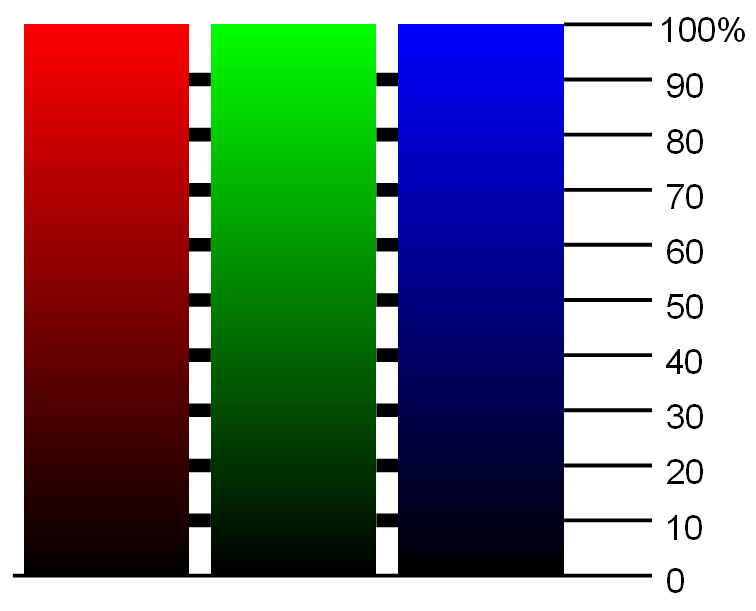
Ideal results: to separate left/right left eye (green and blue tape become goods black) and right eye (red tape becomes quite black)
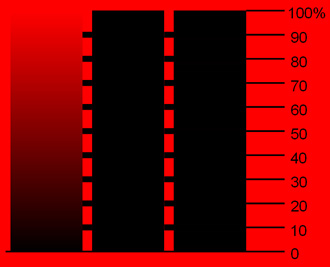
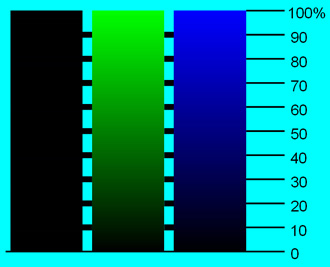
Experimental results: left eye (the red filter lets pass a little green) and right eye (the filter cyan lets pass a little red)
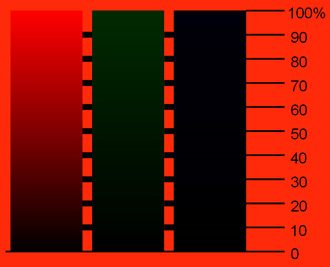
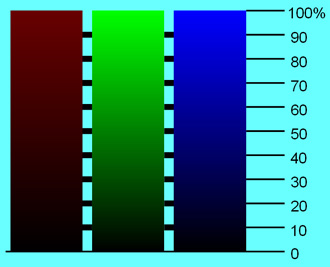
In the case of glasses which separate the two images badly, one can try to superimpose two glasses to narrow the band-width of the filters. The image becomes less luminous then but the components right-left are better separate. One decreases also the ghosts and the chroma crosstalk in the very dark or black areas.
Christmas at Landogne (63), “Cribs of the World”
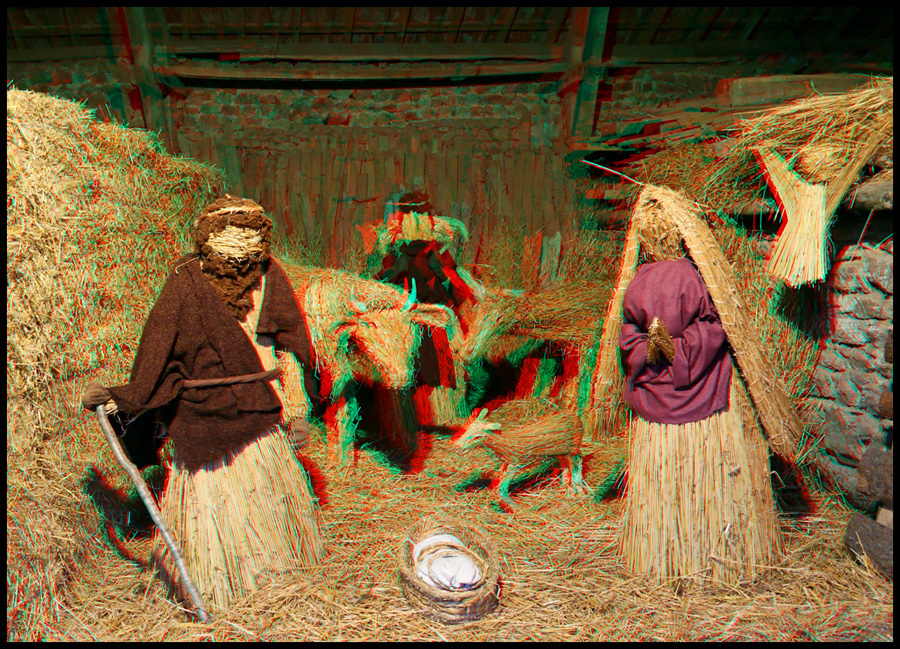
Mask eye after eye to observe the phantom images opposite which can make fuzzy certain areas of the image,
in certain cases the brain can badly react because the information of an eye is found in the other eye:
G: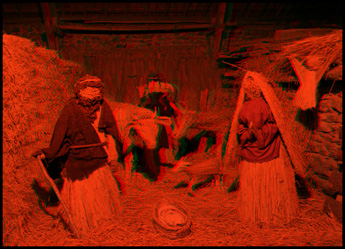 D:
D:
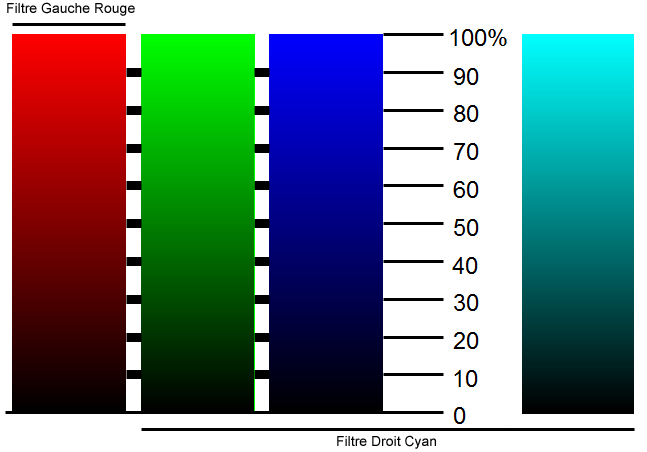













 D:
D:
